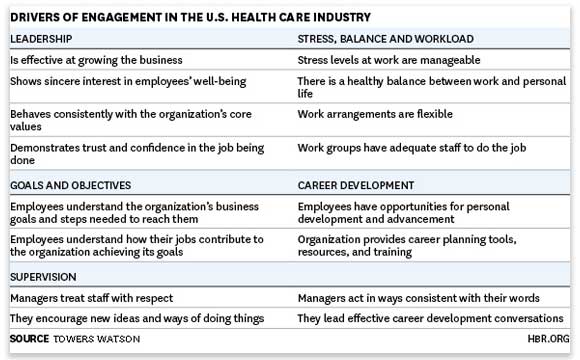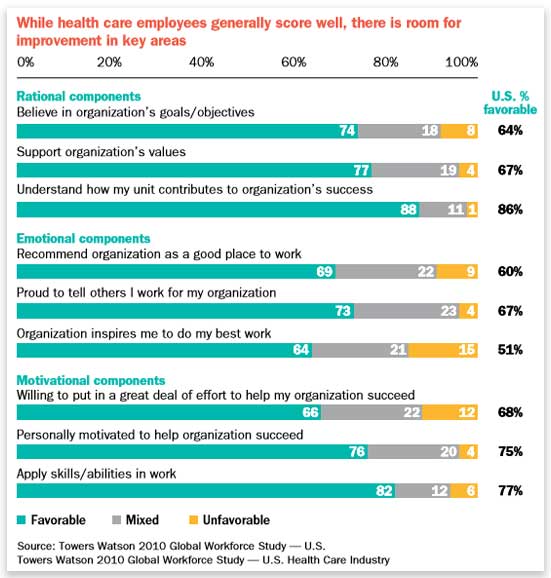As stated by President-elect Donald Trump during presidential election campaigns, he is likely to bring some changes in the Affordable Care Act (ACA). Since many insurers dropped out from ACA’s health insurance exchanges, it is concluded that Americans’ support for the healthcare law is slightly more negative than positive. ACA’s future is unclear and the healthcare industry is expected to undergo major transformations in the years ahead.
Till now, rapid changes in the healthcare industry have adversely affected two important parameters of workforce engagement: understanding work goals and alignment with company’s objectives. Managing manual clinical records, impulsive planning and inefficient hospital processes have further contributed towards employee disengagement. To make the situations worse, the disengaged healthcare professionals have marginalized their perceptions and medical insights into their own patients.

“If people are not engaged, they have choices; patients have choices too.” – said Tony Armada, the CEO of Advocate Lutheran Hospital. Clearly, many healthcare organizations have been facing employee disengagement which has a strong correlation between high employee turnover and dissatisfaction of patients.
In a recent Towers Watson’s global workforce study, it was found that less than half (44%) of the U.S. hospital workforce is engaged. Now the mandate is to improve medical processes in hospitals and safeguard high quality patient experience. This can only be achieved if the healthcare organizations have highly committed, dedicated and skilled medical professionals who greatly impact patient’s experience.
Engaged healthcare employees are emotionally committed to the clinical organization and its goals. Hence medical organizations need to improve workforce engagement to have an advantage of easily finding, hiring and retaining high performing and skilled healthcare professionals

As shown in the above image, each healthcare organization needs to work on improving the experience of medical professionals such that they remain committed for the longer term.
The increasing number of jobs in the healthcare industry has compelled employers to rethink their strategies to engage top talent; especially when so many regulatory reforms like Affordable Care Act (ACA) are changing. More than 90% of supervisors believe that workforce engagement strategy is important, but less than 30% have one. {Source} Healthcare companies need to find better ways to attract and retain top talent.
Healthcare employees struggle with unclear work expectations, lack of open communication and no commitment from leadership to create great workplace, resulting in low employee engagement. A great way to improve workforce engagement in the workplace of healthcare professionals is, by setting a well-planned strategy and automating their HR processes. Fortunately, many talent management and HR software providers have been responsive to the needs of healthcare organizations to automate and speed up their existing processes.
So, what approach should HR managers be adopting to engage top talent in a healthcare industry where work opportunities are endless?
Provide Growth & Development Opportunities
According to Bersin & Associates, organizations that provide workforce development plans have 27% lower turnover rates and each developed employee gives double revenue than an undeveloped employee.
When an employer focuses on enhancing the skill development of its team members through proper training, the employees tend to stay more committed and engaged with their organization and work. The passion to develop new skills in the workforce is highly valued by healthcare employees.
Skill development not only helps employees in advancing in an organization’s hierarchy, but also gives them diversity of experiences to improve their career graph.
Acknowledge Exceptional Contributors & Reward Top Performers
Healthcare employees often create emotional bonds with patients and their family members. It encourages employers to recognize efforts of the healthcare professionals.
With the technology applications, patients and their family can provide direct online feedback on their experience with each healthcare professionals who was involved in their care. It can in turn help HR to easily gain insights into their high performing employees and those who need more mentoring and training.
Providing development opportunities, making work expectations more clear, facilitating open communication and appreciating healthcare employees for exceptional work are some of the things that top performing healthcare organizations are doing differently to build an engaged workforce. In addition to this, implementation of the automated HR tools also improves the quality of managing clinical processes and empowering medical professionals, while keeping costs under control and improving patient’s over all experience.



Thanks for sharing information about How to Improve Workforce Engagement in the U.S. Healthcare Industry…